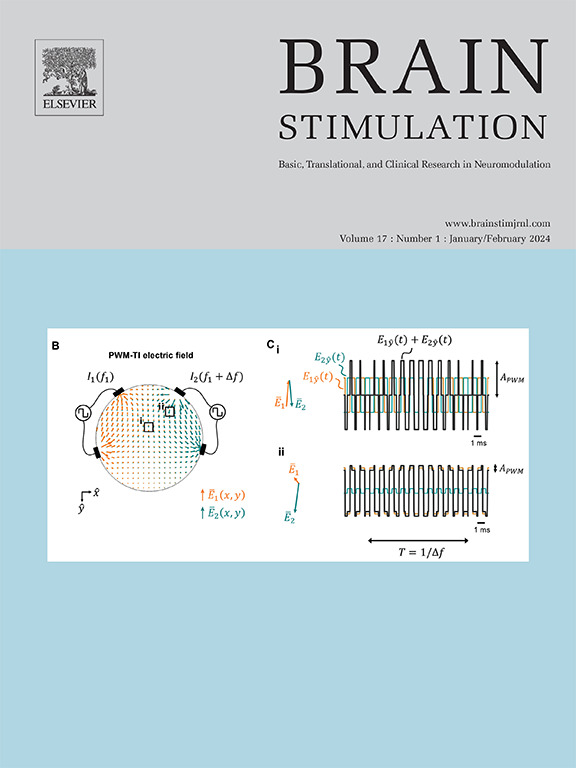itbs诱导的静息状态功能连通性的加速变化与遗忘型轻度认知损伤的认知改善相一致
IF 8.4
1区 医学
Q1 CLINICAL NEUROLOGY
引用次数: 0
摘要
我们发表的加速间歇性θ波爆发刺激(a- itbs)治疗阿尔茨海默病引起的轻度认知障碍(MCI)的I期安全性和可行性试验结果显示,认知能力得到了很大的改善。目的通过确定局部和网络级功能连接的变化是否与观察到的认知改善有关,进一步证明目标参与。方法18例轻度认知损伤患者接受F3束(14400次脉冲)左背外侧前额皮质3天(8次/天)的a-iTBS治疗,并在治疗前后完成MRI和认知测试。基于电场模型,我们选择了3个刺激感兴趣的目标区域(roi),它们分别属于额顶叶(FPN)、默认模式(DMN)和腹侧注意(VAT)网络(3个目标网络)。静息状态功能连接的度量是在ROI级别(网络内度:连接数)和网络级别(隔离:网络内相对于其他网络的连接强度)上计算的。我们将目标roi和网络的认知和连通性变化联系起来;偏离目标的ROI(初级视觉)和网络作为负面控制。结果认知能力的改善与目标roi和网络的连通性变化相关,但与非目标阴性对照无关。l-DMN的程度和目标网络的分离总体上观察到正相关,对DMN和VAT有显著影响。结论a-iTBS对MCI患者认知功能的改善可能与局部和网络层面的功能连接重构有关。这些发现将为进一步评估a-iTBS对MCI认知的神经机制的更大规模试验提供信息。本文章由计算机程序翻译,如有差异,请以英文原文为准。
Accelerated iTBS-Induced changes in resting-state functional connectivity correspond with cognitive improvement in amnestic MCI
Background
Published results of our Phase I safety and feasibility trial of accelerated intermittent theta burst stimulation (a-iTBS) in mild cognitive impairment (MCI) due to Alzheimer's disease showed a large effect-size improvement in cognition.
Objective
Further demonstrate target engagement by identifying whether changes in local and network-level functional connectivity relate to the observed cognitive improvement.
Methods
Eighteen patients with MCI received 3-day a-iTBS (8 sessions/day) to the left dorsolateral prefrontal cortex at Beam F3 (14,400 total pulses) and completed MRI and cognitive testing at pre- and post-treatment. Based on electric field models, we selected 3 stimulated target regions of interest (ROIs) which belonged to the frontoparietal (FPN), default mode (DMN), and ventral attention (VAT) networks (3 target networks). Metrics of resting-state functional connectivity were computed at the ROI level (within-network degree: number of connections) and network level (segregation: strength of connectivity within-network relative to other networks). We correlated changes in cognition and connectivity of the target ROIs and networks; off-target ROI (primary visual) and networks served as negative controls.
Results
Improvements in cognition were associated with connectivity changes in the target ROIs and networks, but not in off-target negative controls. Positive associations were observed for degree of the l-DMN and segregation of target networks overall, with significant effects for DMN and VAT.
Conclusion
Cognitive improvement following a-iTBS in MCI may be attributable to local and network-level reconfigurations in functional connectivity. These findings will inform larger trials designed to further evaluate the neural mechanisms of a-iTBS for cognition in MCI.
求助全文
通过发布文献求助,成功后即可免费获取论文全文。
去求助
来源期刊

Brain Stimulation
医学-临床神经学
CiteScore
13.10
自引率
9.10%
发文量
256
审稿时长
72 days
期刊介绍:
Brain Stimulation publishes on the entire field of brain stimulation, including noninvasive and invasive techniques and technologies that alter brain function through the use of electrical, magnetic, radiowave, or focally targeted pharmacologic stimulation.
Brain Stimulation aims to be the premier journal for publication of original research in the field of neuromodulation. The journal includes: a) Original articles; b) Short Communications; c) Invited and original reviews; d) Technology and methodological perspectives (reviews of new devices, description of new methods, etc.); and e) Letters to the Editor. Special issues of the journal will be considered based on scientific merit.
 求助内容:
求助内容: 应助结果提醒方式:
应助结果提醒方式:


